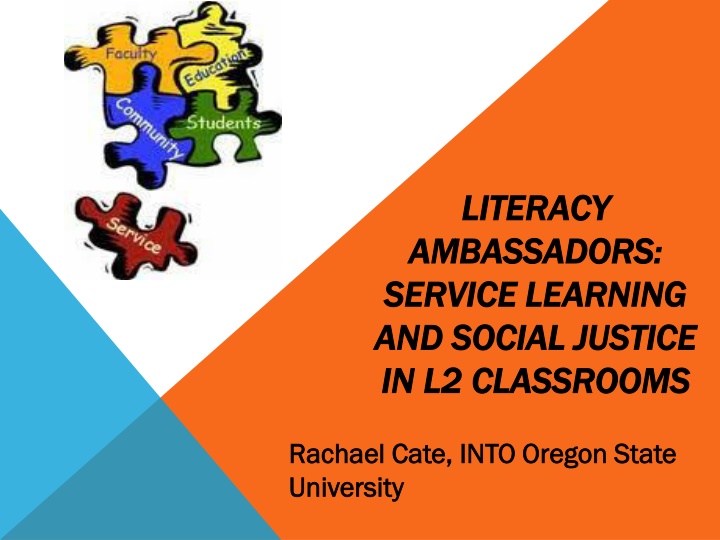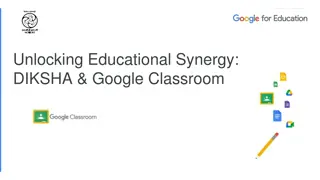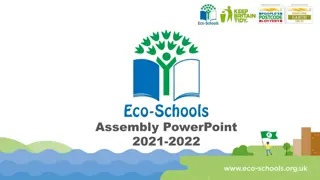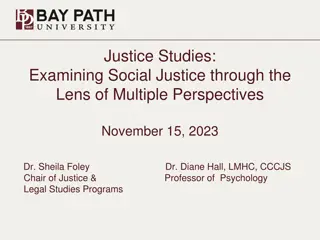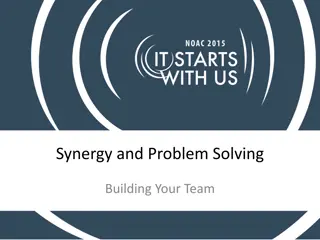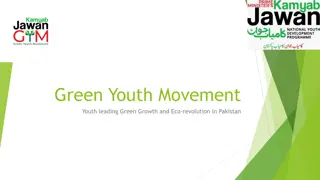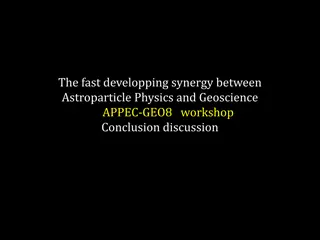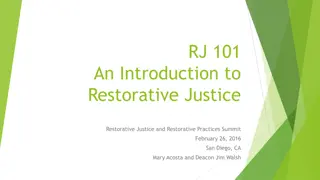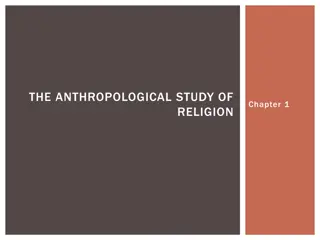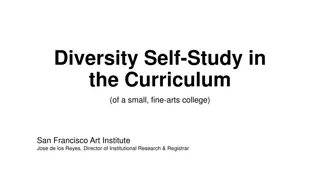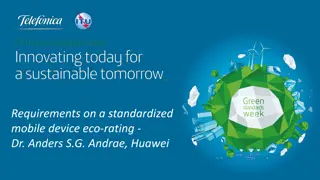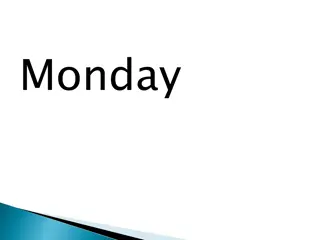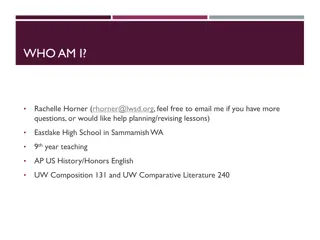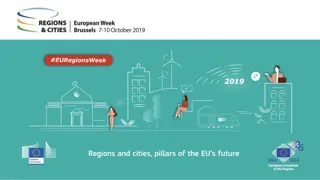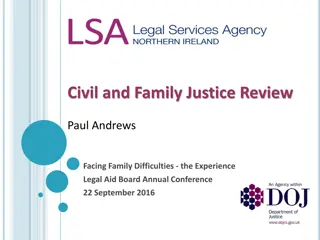Eco-Social Organizations: Synergy, Holism, and Diversity for Service Learning and Social Justice
Explore the concepts of synergy, holism, and diversity within eco-social organizations, emphasizing their role in service learning and social justice. Reflect on the benefits of community service work, learning goals for teachers and learners, qualities of desired community environments, and collaborative participation in creating a sustainable and inclusive learning democracy.
Download Presentation

Please find below an Image/Link to download the presentation.
The content on the website is provided AS IS for your information and personal use only. It may not be sold, licensed, or shared on other websites without obtaining consent from the author.If you encounter any issues during the download, it is possible that the publisher has removed the file from their server.
You are allowed to download the files provided on this website for personal or commercial use, subject to the condition that they are used lawfully. All files are the property of their respective owners.
The content on the website is provided AS IS for your information and personal use only. It may not be sold, licensed, or shared on other websites without obtaining consent from the author.
E N D
Presentation Transcript
LITERACY LITERACY AMBASSADORS: AMBASSADORS: SERVICE LEARNING SERVICE LEARNING AND SOCIAL JUSTICE AND SOCIAL JUSTICE IN L IN L2 2 CLASSROOMS CLASSROOMS Rachael Cate, INTO Oregon State Rachael Cate, INTO Oregon State University University
Reflection activity Reflection activity S Service ervice l learning and social earning and social justice theory justice theory S Scholarly research from service cholarly research from service learning in international learning in international education education I Indigenous ndigenous learning communities communities literacy projects literacy projects Literacy ambassador model Literacy ambassador model Reflection and discussion Reflection and discussion learning 1
REFLECTION: REFLECTION: WHAT IS SERVICE WHAT IS SERVICE LEARNING? LEARNING? Who benefits from community Who benefits from community service work? service work? What are some of your goals as a What are some of your goals as a teacher? teacher? What are some of your goals as a What are some of your goals as a learner? learner? What are some qualities of the What are some qualities of the community do you hope to create community do you hope to create for yourself and your students? for yourself and your students? 2
Synergy, Holism, and Diversity within Eco-social Organizations Synergy: Synergy: When mutual mutual benefits Holism: The practice of seeing the big picture and finding Holism: The practice of seeing the big picture and finding solutions to problems with long solutions to problems with long- -term and broad systematic outcomes in mind outcomes in mind ---J.C. Smuts (1926) Diversity: Variation within an integrated system that adds Diversity: Variation within an integrated system that adds fresh perspectives, strength and adaptability to the system fresh perspectives, strength and adaptability to the system ---E.O. Wilson (1992) When multiple contributors collaborate to achieve multiple contributors collaborate to achieve benefits --Fitjof Capra (1996) term and broad systematic 3
John Dewey John Dewey ( (1859 The School and Society The School and Society ( (1915 1859- -1952 1952) ) 1915) ) Collaborative participation was Collaborative participation was key for Dewey in the key for Dewey in the learning democracy democracy as as primarily a mode of associated living, of mode of associated living, of conjoint communicated conjoint communicated experience experience (quoted in (quoted in Harbour Harbour& & Ebie Ebie, , 2011 According According to Dewey, the motivation to Dewey, the motivation for cooperation and collaboration for cooperation and collaboration within communities of learning, within communities of learning, which is a natural social organizing which is a natural social organizing force based on group affinity and force based on group affinity and mutual goals, is thwarted by mutual goals, is thwarted by traditional competitive classroom traditional competitive classroom environments, while it is encouraged environments, while it is encouraged by joint projects where successes by joint projects where successes are shared. are shared. learning primarily a 2011, p. , p. 8 8). ). 4 Dewey, John. The School and Society. Chicago, Ill: The University of Chicago press, 1915. Print.
Paolo Paolo Freire Freire ( (2000 2000) ) Education as both individual and Education as both individual and community empowerment in community empowerment in collaborative voices and critical collaborative voices and critical inquiry inquiry Praxis: dialectical dynamic Praxis: dialectical dynamic between action between action or engagement and analysis and analysis or or reflection or engagement reflection Transformational learning: Transformational learning: learning that engages with identity learning that engages with identity 5 Freire, Paulo. Pedagogy of the Oppressed. New York: Continuum, 2000. Print.
Service learning scholars: findings Service learning scholars: findings Advantages: authentic motivation for learning project appropriateness/fit for particular communities reciprocal/synergistic benefits of collaborative learning communities, and the promotion of mutual learning interests 6 .
Service learning scholars: findings Service learning scholars: findings Advantages of Cross-cultural Service Learning: broadened worldview broadened worldview (Guenther & Miller, 2011, p. 12) self self- -concept concept, cultural awareness and appreciation, awareness and appreciation, racial understanding racial understanding, high post- graduation aspirations aspirations and readiness to work in diverse work environments environments (Miller & Butler, 2011, p.21) collaboration collaboration, leadership and , leadership and communication abilities communication abilities and accelerating accelerating cultural & racial cultural & racial tolerance while reducing tolerance while reducing stereotypes stereotypes (O Loughlin-Brooks & Smith, 2011, p. 70) sense of social responsibility social responsibility, feelings of connection with their connection with their communities communities, tolerance tolerance for diversity diversity, and cognitive moral development development ( O Loughlin-Brooks & Smith, 2011, p. 73) cultural for diverse work moral 7 .
Ethnography, Participatory Action Research and International Service Learning Education Pre-project exploration Post-project assessment Reflection and Praxis during all stages (Barney, Kirk & Fife, 2011; Flower, 1997; Bridwell-Bowles, 1997; Bacon, 1997; Arca, 1997) 8 .
Indigenous Leaning Communities Indigenous Leaning Communities Testimonios Testimonios: : I I, , Rigoberta Speak Speak (Barrios de Chungara, 1978) , learning projects in Latin America self self- -initiated, auto initiated, auto- -ethnographic transformational learning ethnographic transformational learning communities communities creating spaces for counter creating spaces for counter- -storytelling, critical border storytelling, critical border consciousness consciousness (Anzald a s, 1999) Synergistic, pervasive leadership and community Synergistic, pervasive leadership and community- -building by literacy ambassadors literacy ambassadors Rigoberta Menchu Menchu(Menchu , 1984) and and Let Me Let Me building by 9
Literacy Ambassador Service Learning Model Pervasive Pervasive leadership: leadership: partnering with partnering with community community leaders and leaders and capitalizing on capitalizing on prior knowledge prior knowledge Transformational Transformational Learning Learning Communities and Communities and Community Community- - building building Ethnography/ Ethnography/ Participatory Participatory Action for Action for development, and development, and reflection reflection Offering credit for Offering credit for knowledge knowledge gained in real gained in real- - world experience world experience on students on students terms terms Critical Critical consciousness: consciousness: space for space for questioning the questioning the status quo status quo 10 .
How might you empower your How might you empower your students to identify the students to identify the shared values of their own shared values of their own communities? communities? REFLECTION REFLECTION And to identify literacy work And to identify literacy work that might enable them to that might enable them to become literacy become literacy ambassadors: to pursue ambassadors: to pursue learning goals for their learning goals for their communities that they communities that they identify themselves? identify themselves? How might you ensure that How might you ensure that critical reflection is tied to critical reflection is tied to assessments of project assessments of project learning outcomes? learning outcomes? 11
Discussion: Discussion: Would ESOL service Would ESOL service learning be possible or learning be possible or valuable for your valuable for your classroom? classroom? Thank you! 12
References References ANZALD A, G. (1999). BORDERLANDS = LA FRONTERA. SAN FRANCISCO: AUNT LUTE BOOKS. BARNEY, STEVE T, KIRK, RACHEL, & FIFE, BOYD. (2011). INTERDISCIPLINARY INTERNATIONAL SERVICE LEARNING: THE STORY OF OUR SUCCESS. IN R. L. MILLER, E. AMSEL, B. M. KOWALEWSKI, B. C. BEINS, K. D. KEITH, & B. F. PEDEN (EDS.), PROMOTING STUDENT ENGAGEMENT. VOLUME 1: PROGRAMS, TECHNIQUES AND OPPORTUNITIES (VOL. 1, PP. 73 81). SOCIETY FOR THE TEACHING OF PSYCHOLOGY. RETRIEVED FROM HTTP://TEACHPSYCH.ORG/EBOOKS/PSE2011/VOL1/VOLUME1.PDF BARRIOS DE CHUNGARA, D., & VIEZZER, M. (1978). LET ME SPEAK! : TESTIMONY OF DOMITILA, A WOMAN OF THE BOLIVIAN MINES. NEW YORK: MONTHLY REVIEW PRESS. CAPRA, F. (1996). THE WEB OF LIFE : A NEW SCIENTIFIC UNDERSTANDING OF LIVING SYSTEMS. NEW YORK: ANCHOR BOOKS. DEWEY, J. (1990). THE SCHOOL AND SOCIETY ; AND, THE CHILD AND THE CURRICULUM. CHICAGO: UNIVERSITY OF CHICAGO PRESS. FREIRE, P. (2001). PEDAGOGY OF THE OPPRESSED. NEW YORK: CONTINUUM. GUENTHER, C., & MILLER, R. L. (2011). FACTORS THAT PROMOTE ENGAGEMENT. IN R. L. MILLER, E. AMSEL, B. M. KOWALEWSKI, B. C. BEINS, K. D. KEITH, & B. F. PEDEN (EDS.), PROMOTING STUDENT ENGAGEMENT. VOLUME 1: PROGRAMS, TECHNIQUES AND OPPORTUNITIES (PP. 10 17). SOCIETY FOR THE TEACHING OF PSYCHOLOGY. RETRIEVED FROM HTTP://TEACHPSYCH.ORG/EBOOKS/PSE2011/VOL1/VOLUME1.PDF Menchu , R. (1984). I, Rigoberta Menchu : an Indian woman in Guatemala. London: Verso. MILLER, R. L., & BUTLER, JEANNE M. (2011). OUTCOMES ASSOCIATED WITH STUDENT ENGAGEMENT. IN R. L. MILLER, E. AMSEL, B. M. KOWALEWSKI, B. C. BEINS, K. D. KEITH, & B. F. PEDEN (EDS.), PROMOTING STUDENT ENGAGEMENT. VOLUME 1: PROGRAMS, TECHNIQUES AND OPPORTUNITIES (VOL. 1, PP. 18 23). SOCIETY FOR THE TEACHING OF PSYCHOLOGY. RETRIEVED FROM HTTP://TEACHPSYCH.ORG/EBOOKS/PSE2011/VOL1/VOLUME1.PDF SMUTS, J. C. (2006). HOLISM AND EVOLUTION. [WHITEFISH, MONT.]: KESSINGER PUB. WILSON, E. O. (1992). THE DIVERSITY OF LIFE. NEW YORK: W.W. NORTON. 13
